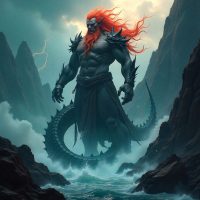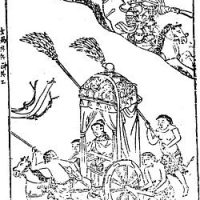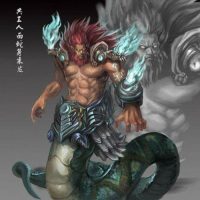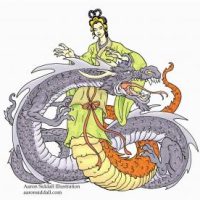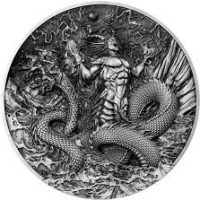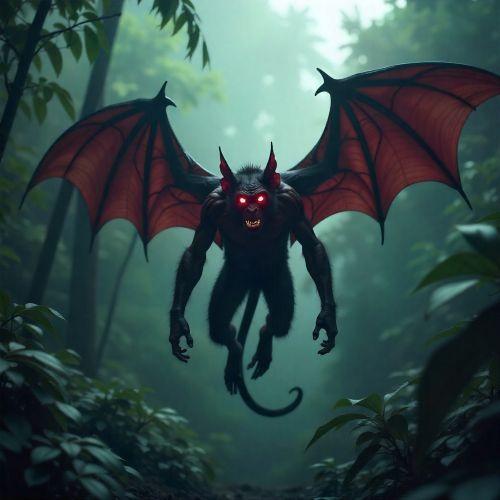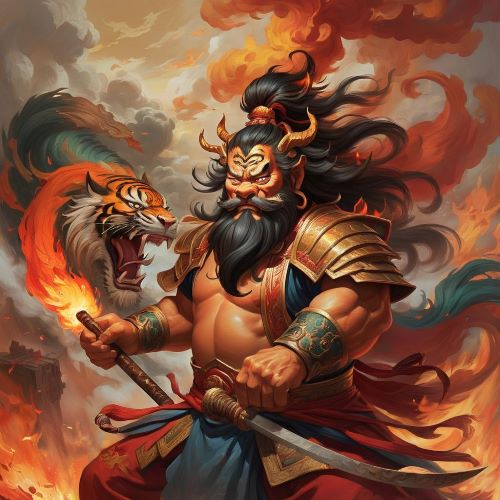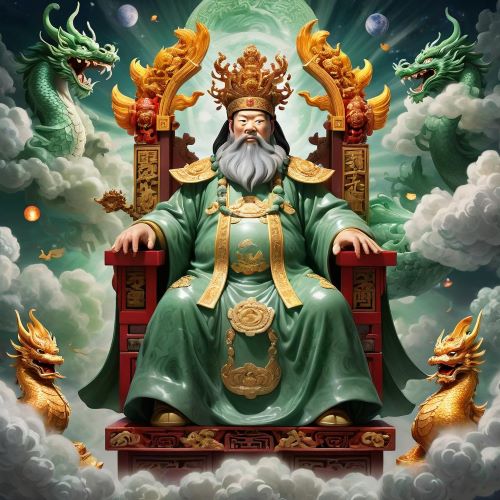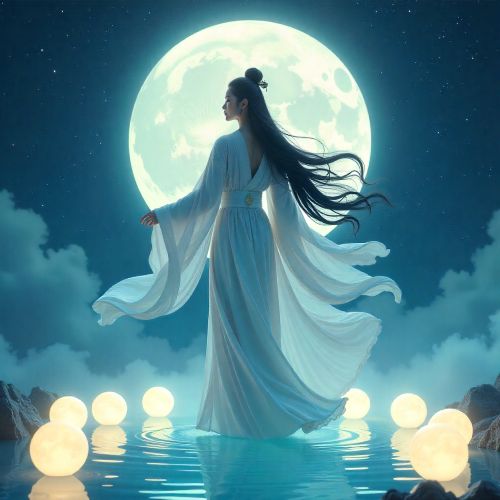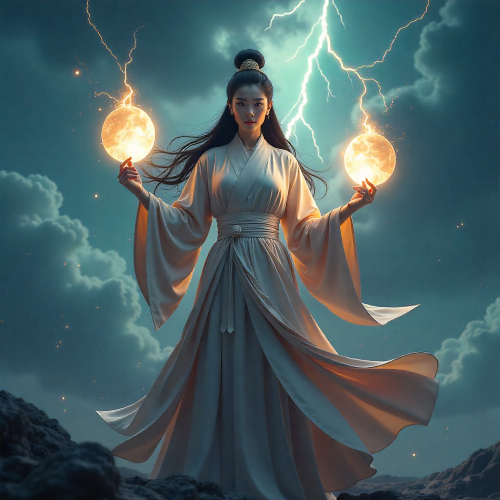Gonggong : The Cataclysmic Water Deity of Chinese Mythology
Listen
At a glance
| Description | |
|---|---|
| Origin | Chinese Mythology |
| Classification | Gods |
| Family Members | N/A |
| Region | China |
| Associated With | Water |
Gonggong
Introduction
Gonggong is one of the most formidable figures in Chinese mythology, remembered as a water deity whose actions disrupted the balance of the cosmos. Often described as the embodiment of chaos, he appears in ancient texts such as the Huainanzi and Shan Hai Jing, where he is portrayed as a rebellious force challenging divine order. His myths explain the origins of catastrophic floods, the tilting of the heavens, and the reshaping of the earth. Through these stories, Gonggong becomes a symbol of uncontrollable natural forces and the consequences of unchecked ambition. The narrative surrounding him also highlights how early Chinese cosmology understood harmony: chaos must exist, but it must also be brought back into balance.
Physical Traits
Descriptions of Gonggong emphasize his fearsome appearance, reflecting his command over destructive waters. He is often portrayed with a humanoid head—sometimes copper-coloured or iron-hard—set atop the long, serpentine body of a black dragon. His vivid red hair, mentioned in several surviving accounts, suggests a restless, volatile temperament, a quality mirrored in the violent floods he brings. In some depictions, Gonggong takes on a more dragon-like or monstrous aquatic form, with scales, frills, or horned features that underscore his supernatural origins. These physical traits reinforce his connection to deep waters and his role as a deity capable of reshaping landscapes.
Family
Gonggong’s lineage remains vague across classical sources, which rarely provide a fixed family tree for him. Some traditions loosely associate him with ancient rulers such as the Yan Emperor or with divine clans linked to early cosmic governance. More consistently, Gonggong appears alongside Xiangliu, his fearsome minister. Xiangliu, known for having nine human heads and a snake-like body, mirrors Gonggong’s destructive nature by poisoning lands and causing widespread flooding. Their relationship emphasizes Gonggong’s authority and the scale of devastation tied to his mythological presence.
Other names
Gonggong appears in historical texts under several transliterations, reflecting variations in regional speech and script over centuries. Names such as Kung-Kung or Gong Gong appear in Western sinological records, while some classical Chinese sources refer to him as Kanghui (康回). Regardless of the variation, these names consistently point to the same deity whose identity centres on rebellion, water-driven catastrophe, and cosmic upheaval. Across all versions, his mythic role remains largely unchanged.
Powers and Abilities
Gonggong’s powers stem from his absolute dominion over water. He is capable of releasing vast floods, shifting the courses of rivers, and causing seas to surge beyond their boundaries. His command of water represents not only physical destruction but also the philosophical concept of chaos within Chinese cosmology. His most famous myth recounts his attempt to seize celestial authority, culminating in a battle against Zhurong, the god of fire. After being defeated, Gonggong’s fury leads him to crash his head into Mount Buzhou—one of the pillars supporting the sky. This impact causes the heavens to tilt northwest and the earth to slope southeast, explaining why rivers in China flow eastward and why certain cosmic patterns appear off-centre. Gonggong’s abilities therefore shape not just the physical world but the mythological explanation of the universe itself.
Modern Day Influence
Gonggong’s legacy continues to appear in modern culture, often as a symbol of powerful natural forces and ecological imbalance. His myth is preserved in contemporary literature, children’s adaptations of ancient Chinese tales, and academic discussions about early cosmology. In 2020, the outer dwarf planet 225088 Gonggong was officially named after him—a recognition of his mythic role in shaping cosmic order. Even the moon of this dwarf planet carries the name Xiangliu, linking astronomy to the ancient mythological relationship. Gonggong also surfaces in popular media, including video games, fantasy novels, and modern art, where he is often portrayed as a force of nature whose presence challenges human resilience. His myth continues to inspire reflections on environmental disruption, human ambition, and the delicate balance between chaos and order.
Related Images
Source
Gonggong. (n.d.). In Wikipedia. https://en.wikipedia.org/wiki/Gonggong_(mythology)[1]
Gonggong: The Titan Whose Fury Shook the Ancient Chinese World. (2025, June 27). Vocal Media. https://vocal.media/futurism/gonggong-the-titan-whose-fury-shook-the-ancient-chinese-world
Water War (Chinese myth). (2018). EBSCOhost Research Starters. https://www.ebsco.com/water-war-chinese-myth
GONGGONG – the Chinese Demon of Water. (2023, June 15). Godchecker. https://www.godchecker.com/chinese-mythology/GONGGONG/
Fate Lines. (2024). The Mythology of Gonggong: Power, Chaos, and Balance. https://fatelines.com/mythology/the-mythology-of-gonggong-power-chaos-and-balance/
Birrell, A. (1993). Chinese Mythology: An Introduction. Johns Hopkins University Press.
Yang, L. (2005). Handbook of Chinese Mythology. Oxford University Press.
Christie, A. (2010). Water and Fire in Chinese Cosmology. Journal of Asian Studies, 69(2), 345–368. https://doi.org/10.1017/S0021911810001234
Wu, K. C. (1982). The Chinese Heritage. Crown Publishers.
Ferrebeekeeper. (2011, May 19). Gong Gong, Nüwa, and the Fragile Nature of Life. Retrieved from https://ferrebeekeeper.wordpress.com/2011/05/19/gong-gong-nuwa-and-the-fragile-nature-of-life/
Fandom. (n.d.). Gong Gong. Myth and Folklore Wiki. Retrieved from https://mythus.fandom.com/wiki/Gong_Gong
Chinaknowledge.de. (2012, January 23). Gong Gong. Retrieved from http://www.chinaknowledge.de/History/Myth/personsgonggong.html
Frequently Asked Questions
Who is Gonggong in Chinese mythology?
Gonggong is a powerful water deity known for causing great floods and cosmic imbalance, particularly after his battle with the fire god Zhurong.
Why did Gonggong destroy Mount Buzhou?
After losing a celestial battle, Gonggong struck Mount Buzhou in rage, causing the sky to tilt and reshaping the natural world.
What does Gonggong look like?
He is typically depicted with a human head, vivid red hair, and a long serpentine or dragon-like body.
What is Gonggong known for?
Gonggong is best known for controlling destructive waters and for the myth explaining the earth’s tilt and directional flow of rivers.
Why is a dwarf planet named Gonggong?
The dwarf planet 225088 Gonggong was named after the deity due to his mythological association with cosmic disruption and celestial imbalance.


